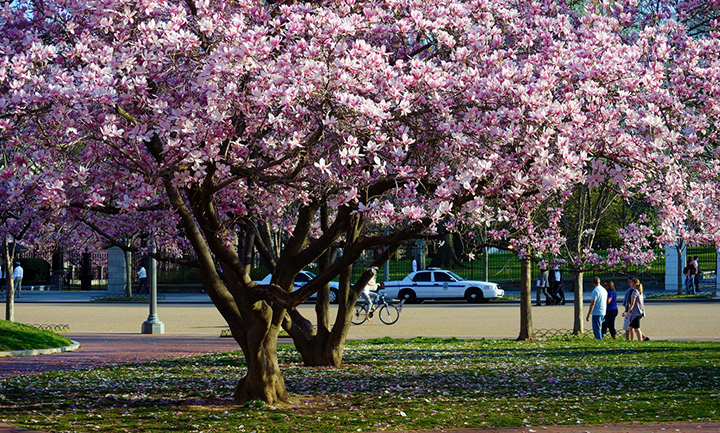Researchers Discover Trees Have A 'Heartbeat' Too
April 24, 2018
Researchers have found that many trees move their branches up and down at night, suggesting they have a pulse.

Magnolia Tree
One of the most important processes sustaining life on Earth is the transport of water from the ground and into the leaves where the photosynthesis and capture of the sun's energy takes place.
The process has fascinated scientists for centuries and is still debated in plant physiology. Scientists generally agree that water transport is driven by light and consequently occurs in 24 hours cycles.
But it was only recently discovered that some other trees also lower their branches by up to 10 centimeters at night and then raise them back up in the morning. These branch movements are slow and subtle, and take place at night, which makes them difficult to identify with the naked eye. However, terrestrial laser scanning, a 3-dimensional surveying technique developed for precision mapping of buildings, makes it possible to measure the exact position of branches and leaves.
A team of researchers from Denmark and Hungary used this technique to conduct an experiment. They brought twenty-two individual tree and shrub species together and scanned them overnight under strictly controlled conditions. They were surprised by the results.
"We detected a previously unknown periodic movement of up to one centimeter in cycles of two to six hours. The movement has to be connected to variations in water pressure within the plants, and this effectively means that the tree is pumping. Water transport is not just a steady-state flow, as we previously assumed," said András Zlinszky of Aarhus University.
The most striking finding was that all the studied plants displayed pulses of minute periodic movement overnight. This was particularly striking in the Magnolia tree, which completed three full cycles of up-and-down branch or leaf movement during one night.
The exact role and mechanism of this process will be studied further, but these findings definitely challenge the widespread view of trees as static, passive organisms.
 Dogs Are Forced To Wear The Things They Steal — And It’s Hilarious
Dogs Are Forced To Wear The Things They Steal — And It’s Hilarious
 Kids Are Loving The Tiny Duck Libraries Popping Up Around New York City
Kids Are Loving The Tiny Duck Libraries Popping Up Around New York City
 A Man Ruined A Beautiful Snowman Display — What Happened Next Was Perfect
A Man Ruined A Beautiful Snowman Display — What Happened Next Was Perfect
 Jonathan And Nancy Fell In Love In Real Life — And So Did Their Stunt Doubles
Jonathan And Nancy Fell In Love In Real Life — And So Did Their Stunt Doubles
 Cat Owner Begs Internet For Advice On How To Get Her Cat To Stop Playing Piano
Cat Owner Begs Internet For Advice On How To Get Her Cat To Stop Playing Piano
 Woman Inherits Her Father's Prosthetic Eyes — And Shares Their Remarkable Story
Woman Inherits Her Father's Prosthetic Eyes — And Shares Their Remarkable Story
 Dogs Are Forced To Wear The Things They Steal — And It’s Hilarious
Dogs Are Forced To Wear The Things They Steal — And It’s Hilarious
 Donkey Gets Tricked Into Taking His Medicine — And It’s Adorable
Donkey Gets Tricked Into Taking His Medicine — And It’s Adorable
 Pig’s Friends Couldn’t Handle Seeing Him So Scared
Pig’s Friends Couldn’t Handle Seeing Him So Scared
 Watch A Forensic Scent Dog Track Down A Hidden Pen
Watch A Forensic Scent Dog Track Down A Hidden Pen
 Watch This 4-Year-Old Girl Steal The Show At A Comedy Club
Watch This 4-Year-Old Girl Steal The Show At A Comedy Club
